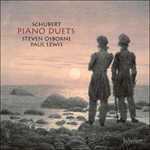The Allegro in A minor, D947 and the Rondo in A major, D951 were written in May and June 1828 respectively, and may well have been intended to form a two-movement sonata along the lines of Beethoven’s E minor Sonata Op 90. Schubert’s rondo is lovingly modelled on the lyrical finale of Beethoven’s sonata: his theme follows a similar harmonic pattern, and even the keyboard layout of its opening bars, with the melody’s initial phrase followed by a more assertive answer in octaves, echoes Beethoven’s. Schubert mirrors Beethoven’s procedure, too, by transferring the final reprise of the rondo theme to the sonorous tenor register, with a continuous pattern of semiquavers unfolding above it. But Schubert’s piece is far from a slavish imitation, and it can more than hold its own against Beethoven’s. Particularly beautiful is the manner in which one of the important subsidiary themes returns towards the end, surmounted by a shimmering pianissimo accompaniment in repeated chords from the primo player. The A major Rondo was published in December 1828, less than a month after Schubert died.
from notes by Misha Donat © 2010
L’Allegro en la mineur D947 et le Rondo en la majeur D951 furent écrits en mai et juin 1828, peut-être dans l’optique d’une sonate en deux mouvements, comme celle de l’op. 90 en mi mineur de Beethoven. Schubert modèle soigneusement son rondo sur le finale lyrique de la sonate beethovénienne: son thème suit un schéma harmonique similaire et il n’est pas jusqu’à l’agencement claviéristique de ses premières mesures—avec la phrase mélodique liminaire suivie d’une réponse davantage affirmative en octaves—qui ne fasse écho à Beethoven. Schubert démarque aussi le procédé beethovénien quand il transfère la reprise finale du thème de rondo au retentissant registre de ténor, avec un schéma ininterrompu de doubles croches se déployant par-dessus. Mais la pièce de Schubert est tout sauf une imitation servile et elle fait plus que tenir bon face à celle de Beethoven. Vers la fin, l’un des importants thèmes secondaires revient de fort belle manière, surmonté d’un chatoyant accompagnement pianissimo, en accords répétés, confié à l’interprète de la partie primo. Le Rondo en la majeur parut en décembre 1828, moins d’un mois après la mort de Schubert.
extrait des notes rédigées par Misha Donat © 2010
Français: Hypérion
Das Allegro in a-Moll D947 und das Rondo in A-Dur D951 wurden im Mai und Juni 1828 komponiert und könnten durchaus als zweisätzige Sonate in der Art von Beethovens Sonate in e-Moll op. 90 gedacht gewesen sein. Schuberts Rondo ist liebevoll nach dem lyrischen Finale von Beethovens Sonate modelliert: Das Thema folgt einem ähnlichen Harmoniemuster, und selbst der Fingersatz der einleitenden Takte, wo auf die erste Melodiephrase eine zuversichtlichere Antwort in Oktaven folgt, ist ein Echo von Beethovens Sonate. Außerdem spiegelt Schubert das Vorgehen von Beethoven, indem er die abschließende Reprise des Rondothemas in die klangvolle Tenorstimme mit einem darüber liegenden durchgängigen Muster von Sechzehnteln verlagert. Doch Schuberts Werk ist bei weitem keine sklavische Imitation und kann sich im Vergleich zu Beethovens Stück mehr als sehen lassen. Besonders hübsch ist die Art und Weise, in der eines der wichtigen Nebenthemen gegen Ende zurückkehrt und von glänzender pianissimo-Begleitung wiederholter Akkorde im ersten Part gekrönt wird. Das Rondo in A-Dur wurde weniger als einen Monat nach Schuberts Tod im Dezember 1828 veröffentlicht.
aus dem Begleittext von Misha Donat © 2010
Deutsch: Henning Weber


 Schubert: Piano Duets
Schubert: Piano Duets
